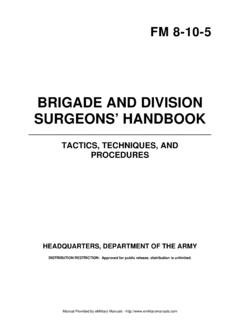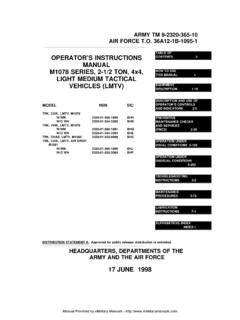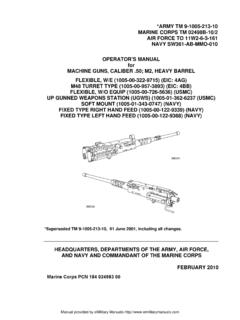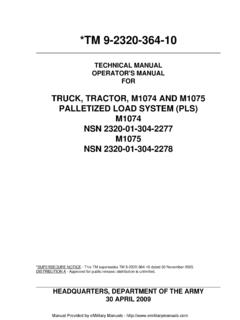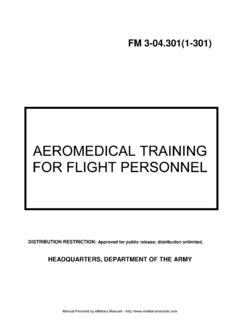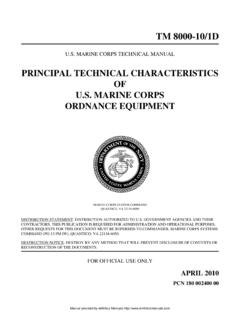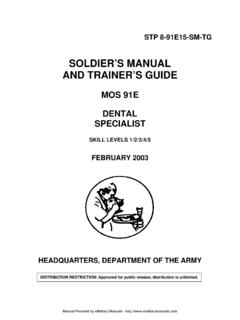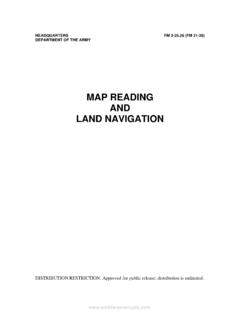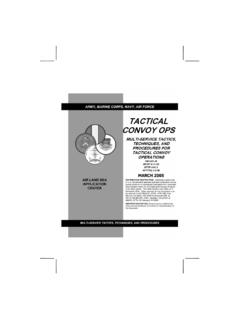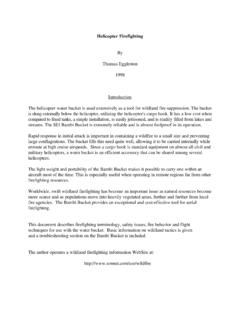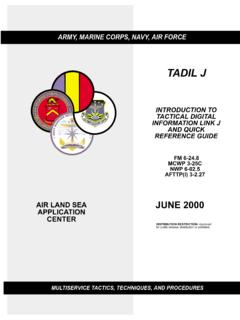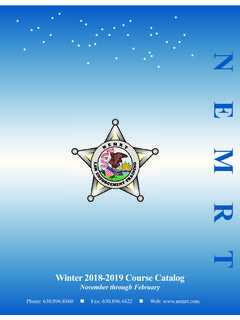Transcription of Patriot Battalion and Battery Operations - eMilitary Manuals
1 HEADQUARTERS. DEPARTMENT OF THE ARMY FM (FM 44-85). Patriot . Battalion AND Battery . Operations . MAY 2002. DISTRIBUTION RESTRICTION: Approved for public release; distribution is unlimited. Manual Provided by eMilitary Manuals - FM 3- (FM 44-85). Field Manual Headquarters Number Department of the Army Washington, DC, 13 May 2002. Patriot Battalion and Battery Operations Contents Page v Chapter 1 OVERVIEW .. 1-1. Army Mission .. 1-1. ADA Mission .. 1-1. ADA Role .. 1-1. Patriot Mission .. 1-2. Patriot Roles .. 1-2. Chapter 2 THREAT .. 2-1. Contingency Theater Threat .. 2-1. Threat During Lodgment .. 2-5. Threat During Operations .. 2-6. Chapter 3 Patriot Battalion PLANNING .. 3-1. AMD Planning Overview .. 3-1. Patriot Battalion Planning .. 3-5. Chapter 4 force -PROJECTION 4-1. force Projection 4-1. Mobilization .. 4-2. 4-4. Employment .. 4-5. 4-7. Sustainment .. 4-8. Distribution Restriction: Approved for public release; distribution is unlimited.
2 Supersedes FM 44-85, dated 21 February 1997. i Manual Provided by eMilitary Manuals - FM Chapter 5 5-1. Offensive 5-1. Defensive 5-6. Defense Designs .. 5-7. TBM 5-9. Stability Operations and Support 5-11. Remote Launch .. 5-11. AMD Task force 5-13. Command, Control, Communications and Intelligence .. 5-19. TBM Operational Engagement Effectiveness 5-21. Integrated Firing Doctrine Principles .. 5-24. Chapter 6 Patriot COMBAT SERVICE SUPPORT .. 6-1. Patriot Support Concept .. 6-1. Organizations and 6-1. 6-8. Operations .. 6-9. 6-11. Categories of Supplies . 6-12. Classes of Supply .. 6-13. Maintenance .. 6-20. Transportation .. 6-23. Field Services .. 6-23. Rear Area Base 6-24. 6-27. Appendix A A-1. Patriot Battalion .. A-1. Headquarters and Headquarters Battery .. A-1. Patriot Battery (Fire Unit).. A-4. Appendix B Patriot SYSTEM EQUIPMENT .. B-1. System B-1. Physical Description of Major Items.
3 B-3. Tactical Equipment Weights and B-14. ii Manual Provided by eMilitary Manuals - Table of Contents Appendix C COMMUNICATIONS .. C-1. Overview .. C-1. Battalion Communications .. C-2. Battery C-8. Air and Missile Defense Task force Communications .. C-11. Patriot Communications C-14. Standardization .. C-17. System Initialization .. C-20. Data Link C-20. Tactical C-21. Recommendations .. C-22. Appendix D INTELLIGENCE PREPARATION OF THE BATTLESPACE .. D-1. Role of the Commander and Staff in D-1. IPB Process .. D-1. Battlespace's Effects On Enemy And Friendly Capabilities D-10. Appendix E E-1. Responsibilities .. E-1. Identifying and Assessing Safety Issues .. E-1. Patriot System Safety .. E-2. Vehicle Movement and Convoys .. E-5. AMD Task force E-6. Appendix F F-1. Transportability Overview .. F-1. C-5 Characteristics. F-3. C-17 Characteristics .. F-3. MEP Air Transportability.
4 F-3. Special Air Transportability F-5. Appendix G RECONNAISSANCE, SELECTION, AND OCCUPATION OF POSITION .. G-1. Preparation For Movement G-1. Methods Of Reconnaissance . G-2. Establishing A Team G-3. RSOP Team . G-4. iii Manual Provided by eMilitary Manuals - FM Movement Warning Order G-6. Ground/Site Reconnaissance G-6. Laying Out The Position .. G-7. Equipment Considerations . G-8. Occupy, Organize And Improve Positions .. G-11. GLOSSARY . Glossary-1. BIBLIOGRAPHY .. Bibliography-1. INDEX .. Index-1. iv Manual Provided by eMilitary Manuals - Preface This field manual provides doctrinal how-to-fight guidance for the Patriot Battalion and Battery , and is intended primarily for Battalion commanders, staff officers, Battery commanders, platoon leaders, and tactical directors. This FM is applicable to all theaters of Operations . It focuses on Patriot 's role in the projection of land and air combat power.
5 Chapters address Patriot 's role in the joint battle, the threat, Battalion planning, force - projection Operations , offensive and defensive Operations , and combat service support. Appendices cover unit organization, equipment, communications, intelligence preparation of the battlespace, safety, transportability, and reconnaissance, selection, and occupation of a position. This FM should be used in conjunction with FM , which describes the tactics, techniques and procedures required to execute Patriot Operations and exploit Patriot 's combat power. Classified capabilities and planning data for the Patriot system are found in (S) FM (S/NF). This publication implements the following international standardization agreements: ISA TITLE EDITION. STANAG 2175 Classification and Designation of Flat 3. Wagons Suitable for Transporting Military Equipment STANAG 2832 Dimensional Restrictions for the Transport 3.
6 Of Military Equipment by Rail on European Railways STANAG 3700 NATO Tactical Air Doctrine--ATP-33 (B) 5. STANAG 3805 Doctrine for Airspace Control in Times of 5. Crisis and War--ATP-40 (B). STANAG 3880 Counter Air Operations --ATP-42 (B) 3. The proponent for this publication is HQ TRADOC. Send comments and recommendations on DA Form 2028 to Commandant, United States Army Air Defense Artillery School, ATTN: ATSA-DT-WF, Fort Bliss, Texas 79916-3802. Unless this publication states otherwise, masculine nouns or pronouns do not refer exclusively to men. v Manual Provided by eMilitary Manuals - Chapter 1. Overview This chapter discusses the missions of the Army and air defense artillery as well as the role ADA plays in protecting the force . It also describes the Patriot mission and the roles Patriot plays in supporting the various types of air and missile defense (AMD) Operations .
7 ARMY MISSION. 1-1. The mission of the Army is to fight and win the nation's wars, defend the United States and its territories, and support national policies and objectives articulated in the National Security Strategy and National Military Strategy. 1-2. The Army accomplishes this mission through a force structure comprised of combat, combat support, and combat service support forces. Combat forces provide destructive capabilities to defeat the enemy. These forces include, armor, aviation, infantry, and Special Forces units. Combat support forces provide fire support and operational assistance to combat forces. These support forces include the ADA, field artillery, engineers, chemical, military intelligence, military police, and signal units. Combat service support forces provide essential support required to sustain Operations throughout a campaign. These forces include the medical, transportation, quartermaster, ordnance, and several other units.
8 1-3. The above forces are normally employed within a joint theater of Operations , and their activities integrated, coordinated, and synchronized with those of joint and multinational forces in support of the joint or multinational force commander. ADA MISSION. 1-4. The mission of ADA is to protect the force and selected geopolitical assets from aerial attack, missile attack, and surveillance. Aerial threats include fixed-wing and rotary-wing aircraft as well as unmanned aerial vehicles configured to conduct attack missions. Missile threats include unmanned aerial vehicles (UAVs) and theater ballistic missiles (TBMs), cruise missiles, and air to surface missiles. Surveillance threats include UAVs and other air platforms configured to conduct reconnaissance, surveillance, and target acquisition Operations . ADA ROLE. 1-5. The role of ADA is to provide integrated in-depth defensive counterair (DCA) protection of forces and critical assets in the theater, corps, and divisional areas.
9 This protection contributes to the defeat of enemy forces 1-1. Manual Provided by eMilitary Manuals - FM through destruction of his offensive capabilities. It also contributes to the success of friendly forces by protecting the force and contributing to air supremacy at both the tactical and operational levels. 1-6. All members of the combined arms team perform air defense Operations ;. however, ground-based ADA units execute most of the Army's force - protection mission. These units protect deployed forces and critical assets within a theater by preventing enemy manned aircraft, missiles, and UAVs from locating, striking, and destroying friendly forces and assets. 1-7. Today, the threat to friendly forces is significantly greater than in the past because potential adversaries possess weapons of mass destruction (WMD) and have access to updated technology. The prospect of catastrophic loss of soldiers and the disruption of operational plans and objectives highlights the importance of air and missile defense Operations in creating and sustaining combat power within a theater.
10 Patriot MISSION. 1-8. The mission of Patriot is to protect the forces and selected geopolitical assets from arial attack, missile attack, and surveillance. Patriot provides protection against theater ballistic missiles (TBMs), and air threats for critical assets in the corps, and echelons above corps (EAC) areas. Patriot can be tailored to the tactical situation in defending against air, and missile attack. Patriot ROLES. 1-9. Because of the Patriot system's firepower, range, and altitude capabilities, the normal role of the Patriot system is to accomplish the air defense mission within the very low-altitude to very high-altitude boundaries. Patriot is the lower level tier of a two-tier TBM defense system. 1-10. Patriot units are employed to protect forces and critical assets in all types of Operations . Patriot units may be deployed individually or as part of an AMD task force to protect entering forces, airfields, seaports, transportation centers, population centers, command, control, communications, computers, and intelligence (C4I) activities and geopolitical assets.
